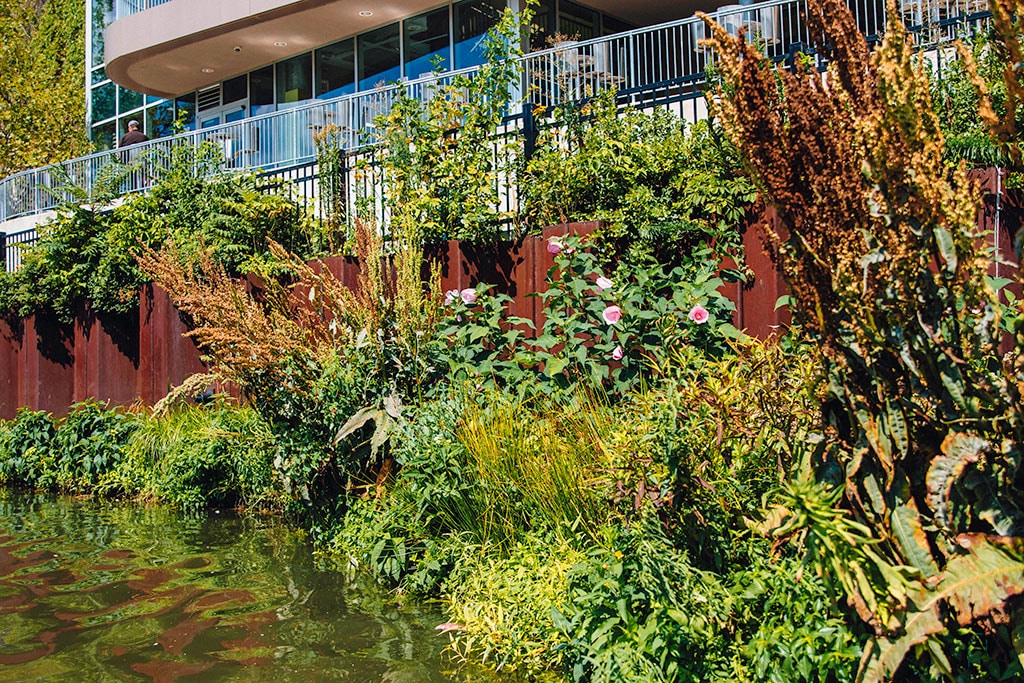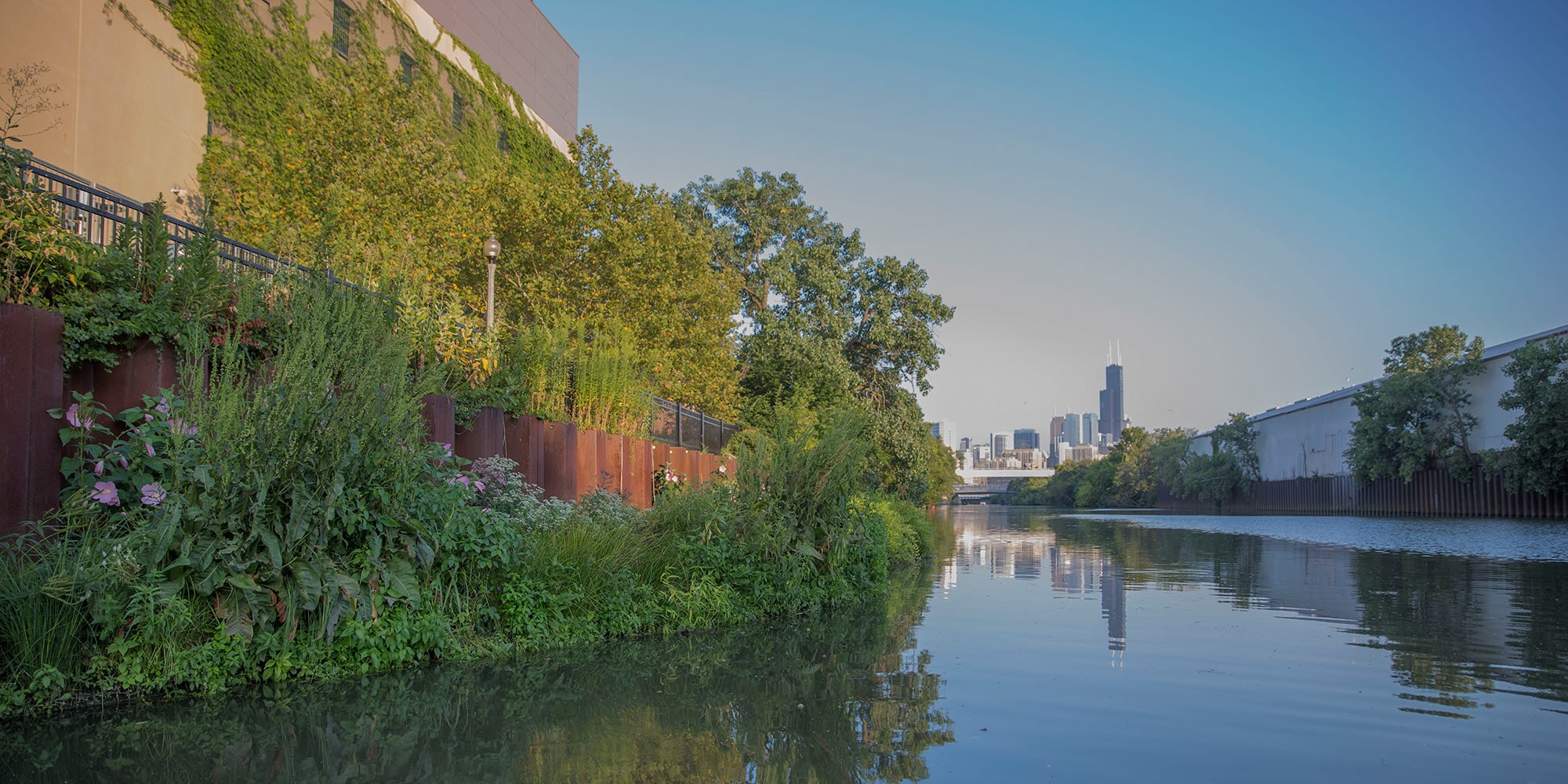If Babylon was remembered over the millennia for its hanging gardens, perhaps Chicago will be known for its floating ones.
Urban Rivers, a nonprofit founded by Zachary Damato, Nick Wesley and Josh Yellin, aims to create a mile of native wetlands, forest, public walkways and kayak access points suspended on floats along the east shore of Goose Island in the North Branch Canal of the Chicago River.
They’re calling it “The Wild Mile,” and it aims to be the first mile-long floating eco-park in the world.
More than breaking records, though, the goal is to reintroduce native plants and grasses, and clean the river’s polluted waters enough to bring local fish, birds, turtles, muskrats and otters back home.
An industrial river
Understanding how revolutionary this idea is requires a quick trip through history. For decades, the Chicago River has served a functional purpose: to transport people and goods for the City That Works.
In 1900, the Sanitary District of Chicago completed an extraordinary feat of engineering and reversed the flow of the river. For most of the following century, it carried mostly barges, garbage, and sewage. You wouldn’t want to swim in these waters.
In recent decades, the river has become more people-focused. Two of the city’s most popular tourist attractions are the water taxi to Chinatown and architectural boat tours, which take riders on a meandering journey through the shadows of some of Chicago’s notable buildings, designed by the likes of Daniel Burnham, Bertrand Goldberg and Jeanne Gang. Not to mention the St. Patrick’s Day tradition of dyeing the river green, which draws thousands of spectators each year.
During his second term in office, Mayor Rahm Emanuel ramped up downtown revitalization of the waterway by redeveloping the riverwalk and turning it from an area often avoided by commuters to a walkable destination with landscaping elements and restaurants, which patrons can access by boat. Earlier this year, he announced another phase: a $10 million riverwalk revamp to take place over the next two years.
“The river has this identity crisis,” Damato explains. “It’s in transition. It’s not 100 percent industrial like it was in the ’70s or ’80s, but it’s not hugely recreational like it could be in another 10 years.”
An evolution
The idea for Urban Rivers began with three acquaintances and their desire to grow fruits and vegetables within the city. Nick Wesley had an interest in hydroponics and had once used river water to grow lettuce in college. In 2014, mutual friends introduced him to Joshua Yellin, who was finishing up his thesis on using floating islands as fish habitats for his master’s degree at the University of Illinois at Urbana-Champaign and had already constructed a 50-square-foot raft in the river to evaluate its efficiency. Once tech enthusiast Zachary Damato connected with the pair, they set to work designing the floats, sourcing materials, and exploring the necessary permissions for building a structure on a city waterway.
The trio quickly discovered the challenge of navigating the plethora of bureaucracies and stakeholders in the river. Federal, state and city authorities all had to approve permits for the floating gardens—as did the property owners and adjacent property owners.
The initial permitting process took nine months; creating a floating garden in the river was unprecedented. But in June 2017, the first 1,500 square feet of the floating park was finally installed. Eighty coconut fiber beds line the river’s edge outside the Goose Island Whole Foods store. Greenery spills over the the floats and into the water, transforming the brutalist steel river wall into a more serene and natural shoreline. A narrow boardwalk provides space for pedestrians to explore the habitat.
“It’s a good start, but we’re going to need miles of gardens and habitat to clean the river,” Damato says. “It’s possible, but more than that, it’s necessary.”

Photo Courtesy: Urban Rivers
Not only will the root systems of trees, plants, and native grasses begin to absorb and break down pollutants in the river’s dirty waters, the whole ecosystem aims to create a habitat for land water animals whose natural functions aid in eliminating toxins from the environment.
Urban Rivers partnered with Biomatrix Water, which created UV-resistant, thermo-fused floats with marine-grade engineering that can stand up to year-round weather. It’s a malleable design that features stainless steel locking mechanisms so future modules can be added at will.
“This year has been dedicated to experiments that will scale with the Wild Mile and diversify the habitat,” Damato says. That experimentation has included submerged modules with the kind of underwater plant species that will attract marine life, as well as a topside vegetable garden of lemon basil, rosemary, Brandywine tomatoes, kale and summer squash.
Damato was quick to clarify that this agricultural component proved the toxicity of the water—they tested the crops and determined that they weren’t safe for widespread consumption—but it represents the opportunity for an improved future.
“Between North Avenue and Halsted Street, no barges go through,” Damato says. “It’s a unique place to create a lush sanctuary.”
Damato and his team hope that sanctuary will one day provide a homecoming for native fish (bluegill, common carp, spotfin shiners); birds (American coots, English sparrows, cormorants, great blue herons, ducks); insects (monarch butterflies, dragonflies, damselflies, bees); amphibians (bullfrogs, American toads); and mammals (field mice, muskrats, river otters).
Eventually, Urban Rivers also wants to increase the garden’s human focus by adding a yoga deck and floating classroom that can host local student groups studying science, tech, engineering, arts and math.
To get there, they have more work to do. Phase two of the project calls for a 220-foot walkway from the shore to the floats (right now, the gardens are only accessible by kayak), and the team is constructing floats that can support full-grown trees. They’re even experimenting with a “trash bot” prototype, which motors around the waterway scooping up floating garbage.
It’s all part of their unbridled belief that technology can save the world. “It’s possible,” Damato says. “But it takes resources, politics and support. You can’t change science, but you can change opinion through pocketbooks and corporate support.”
Editor’s note: Urban Rivers has been a nonprofit partner of REI since 2017. An REI contribution totaling $6,000 has helped support the organization’s efforts over the years.


